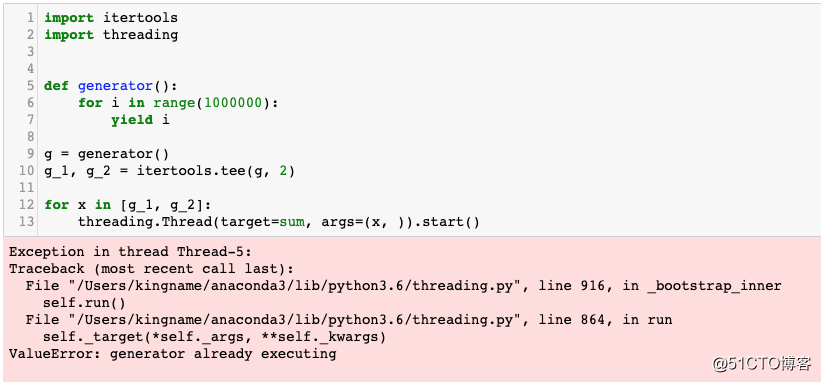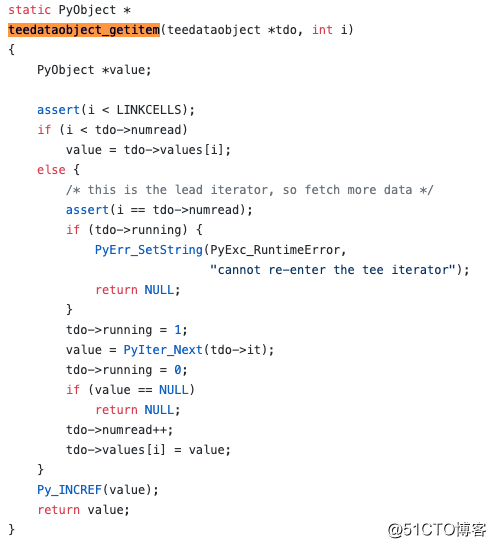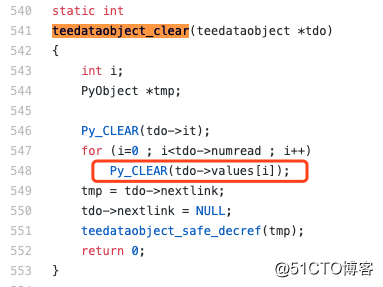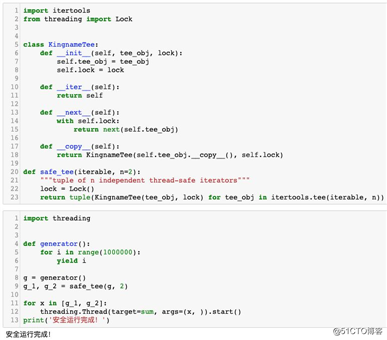一日一技:如何让 itertools.tee 线程安全
2021-03-12 19:28
标签:image 效果 info end 理解 生成 mod 参考资料 lock 摄影:产品经理 在两个线程里面同时运行分裂出来的生成器对象,就会导致报错。 现在,你想看看itertools.tee的源代码,但是你会发现,在 PyCharm 里面,它的源代码如下图所示: 导致问题的核心部分在如下图所示的两段代码中: 大家看不懂也没有关系,根据我上一篇文章中使用 Python 实现的简化版本就足够帮助理解了。 我们使用简化版本来解释其中线程不安全的地方: 当两个线程同时运行到if not queue时,发现当前各自的队列都是空的,于是进入value = next(g)获取下一个值。其中,线程 A 先进入那么几毫秒。然后线程 B 进入value = next(g)。但由于此时线程 A 中的next(g)正在运行,尚未结束,线程 B 又跑来运行,于是就导致了报错的发生。Python 中,生成器不是线程安全的。 那么如何让itertools.tee分裂出来的多个生成器可以在多线程中运行呢?其关键因素就是让value = next(g)这一行一次只能让一个线程运行。所以我们可以通过加锁来实现。 我们来看看运行效果: 多线程完美运行。 参考资料 [1] 一日一技:如何让 itertools.tee 线程安全 标签:image 效果 info end 理解 生成 mod 参考资料 lock 原文地址:https://blog.51cto.com/15023263/2558921
一起吃:kingname & 产品经理
在上一篇文章中,我们说到了,itertools.tee不是线程安全的,并给出了一个例子,如下图所示:

这是因为,在 CPython 中,itertools.tee底层是通过 C 语言实现的,所以你不能在 PyCharm 中看到它的源代码。但是你可以通过阅读 Python 的源代码中的 Modules/itertoolsmodule.c 文件[1],找到它的实现算法。

def generator():
for i in range(3):
yield f‘我是你第{i}个爷爷‘
def split(g):
value_list_1 = []
value_list_2 = []
def wrap(queue):
while True:
if not queue:
try:
value = next(g)
except StopIteration:
return
value_list_1.append(value)
value_list_2.append(value)
yield queue.pop(0)
g_1 = wrap(value_list_1)
g_2 = wrap(value_list_2)
return g_1, g_2
g = generator()
g_1, g_2 = split(g)
for value in g_1:
print(value)
for value in g_2:
print(value)
import itertools
from threading import Lock
class KingnameTee:
def __init__(self, tee_obj, lock):
self.tee_obj = tee_obj
self.lock = lock
def __iter__(self):
return self
def __next__(self):
with self.lock:
return next(self.tee_obj)
def __copy__(self):
return KingnameTee(self.tee_obj.__copy__(), self.lock)
def safe_tee(iterable, n=2):
"""tuple of n independent thread-safe iterators"""
lock = Lock()
return tuple(KingnameTee(tee_obj, lock) for tee_obj in itertools.tee(iterable, n))
Python 的源代码中的Modules/itertoolsmodule.c文件: https://github.com/python/cpython/blob/master/Modules/itertoolsmodule.c